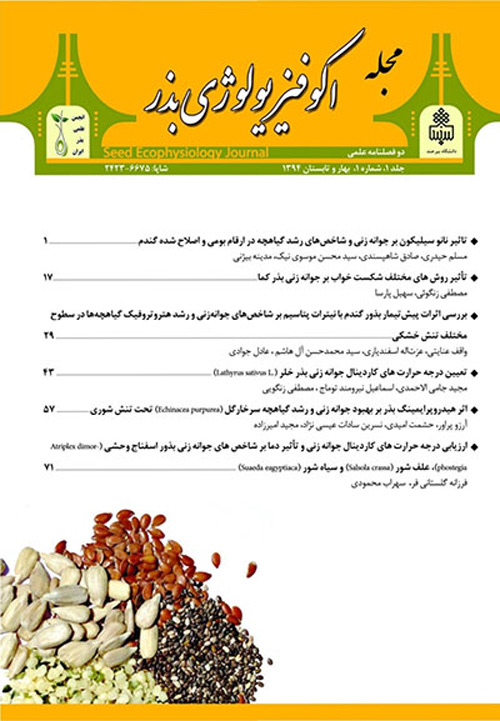Comparision the effect of hydropriming and osmopriming on germination and seedlings heterotrophic growth of peanut (Arachis hypogaea L.)
The Peanut (Arachis hypogaea L.) is one of the most important and most economical oilseed crops in tropical and subtropical regions, mostly cultivated in order to produce oil and protein (Maiti and Ebeling, 2002; Smartt, 1994). Hydropriming increases viability in peanut seeds (Ponnuswamy and Karivaratharaju, 1993). Osmopriming peanut seed using calcium chloride increases the percentage of germination. In addition, significant changes can be observed in many germinated seedling characteristics in solutions containing calcium chloride (Datta et al., 1990). Heterotrophic growth of seedlings can be divided into the two components; 1. Weight seed reserves transferred and 2. Conversion efficiency of seed reserves transferred to the seedling tissue (Zeinali and Soltani, 2001; Soltani et al., 2002; Soltani et al., 2006) that this steps is strongly influenced by the quality of the seed (De Figueiredo et al., 2003). Therefore, present study was conducted in order to evaluate the effect of seed priming on germination and heterotrophic growth of peanut seedlings.
The present study was conducted at factorial experiment based on randomized complete block design at Faculty of Agriculture, Islamic Azad University of Rasht. Experimental treatments were 2 levels of seed size (medium and large), 2 levels of priming type (hydropriming and osmopriming) and 4 levels of priming time (30, 60, 90 and 120 minutes). In order to hydropriming and osmopriming of peanut seeds was used distilled water at neutral pH and calcium chloride solution with a concentration of 0.1%, respectively. The experiment was conducted with 150 seeds of each experimental treatment in 3 replicates of 50 seeds. Before performing priming, disinfection of seeds peanuts using mercuric chloride was 1% (Nautiyal, 2009). Time drying primed seeds was half an hour. For standard germination test, each treatment for 10 days at a constant temperature of 25 ° C was the germination germinator. For this test the germination was used from method of between wet papers (Hampton and TeKrony, 1995). Identify and counting of normal and abnormal seedlings from day 5 to 10 was based on ISTA instructions (ISTA, 2011; Don, 2009). On the last day of the test germination, seedlings and its components dried in the oven at 60 ° C for 24 hours (Maiti and Ebeling, 2002). In this study, the Indexes and traits included: Final Germination Percentage, Germination Rate, Mean Velocity Germination, Coefficient of Germination Speed, Mean Germination Time, Mean daily Germination, Coefficient of Uniformity of Germination (Germination Indexes), Total Dry Weight, Seedling Dry Weight, Radicle Dry Weight, Plumule Dry Weight, Hypocotyl Dry Weight, Fragment Seed Dry Weight, Seed Reserve Use Rate, Seed Reserve utilization Efficiency, Seed Use Reserve Fraction (Seedlings Heterotrophic Growth), Radicle Length, Hypocotyl Length, Plumule Length, Seedling Length (Length traits), Seedling Length Vigour Index and Seedling Weight Vigour Index. The data obtained was analyzed using the software MSTAT-C. In addition to analysis of variance, LSD method was used to Comparisons of average data.
The results showed that effect of peanut seed size on all indices (other than coefficient of germination speed) and components of heterotrophic growth was significant (P <0.01). The effect of priming type (P <0.05) showed that the maximum germination percentage (79.17 percent), mean velocity germination, mean daily germination and coefficient of uniformity of germination was related to osmopriming. Effect of priming type in priming time (P <0.05) showed that the maximum Seed Reserve utilization Efficiency and Seed Use Reserve Fraction were in the treatment of osmopriming during 60 minutes. Also, maximum seedling weight vigour index was in treatment of osmopriming during 120 minutes. The effect of seed size, priming type and priming time (P <0.05) showed that the maximum seedling length vigour and Seed Reserve utilization Efficiency were in 90 and 120 minutes hydropriming, respectively and maximum coefficient of germination speed and mean germination time were in 30 hydropriming and 90 minutes osmopriming, respectively. The overall, maximum germination and heterotrophic growth was obtainedin osmopriming with calcium chloride 0.1%. Rangaswamy et al. (1993) and also Narayanaswamy and Channarayappa (1997) showed that the maximum percentage of germination the seeds of peanuts were in calcium chloride of 0.4 and 0.5 percent, respectively. also, Massarat et al. (2013) reported that the germination percentage and other indices of germination were under the influence of priming had significant differences. Use of calcium chloride caused the maximum vigour index in peanuts. Fu et al. (1993) also reported that priming peanuts with calcium chloride has to increase vigour index. In general, osmotic priming to control water absorption, improved the plasma membrane, reducing the loss of electrolytes, improve the vigour in seeds (Koocheki and Sarmadnia, 2007).
- حق عضویت دریافتی صرف حمایت از نشریات عضو و نگهداری، تکمیل و توسعه مگیران میشود.
- پرداخت حق اشتراک و دانلود مقالات اجازه بازنشر آن در سایر رسانههای چاپی و دیجیتال را به کاربر نمیدهد.



